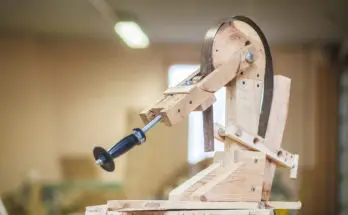If you are new to woodworking, getting started in the hobby can feel like a daunting task. Using power tools that have sharp blades rotating thousands of times per minute can be terrifying and make you want to explore other hobbies.
Fortunately, if you are new to woodworking, there are several paths that you can take to enter the hobby and build up your confidence and prepare yourself for the dangers associated with the hobby.
How safe is woodworking? The fact is, woodworking is very dangerous, however, this risk can be mitigated by taking the proper steps and learning to respect the tools you are using rather than fearing them.
Most Common Injuries
It should come as no surprise, that the most common areas of injuries for a woodworker are those to the hands, fingers and eyes. The table saw is one of the most commonly found saws in a workshop. It’s also responsible for causing the most amount of visits to the emergency room. A study conducted by the National Electronic Injury Surveillance System (NEISS) estimated that approximately 80,000 hospital trips were due solely to the table saw.
To offer some perspective, were the second leading cause for emergency room visits within all woodworking tools. Circular saw injuries account for about 20,000 ER visits per year.
In accidents where saws were responsible for sending someone to the hospital, approximately 65% of cases were due to lacerations. Even more surprising, more than 10% of hospital visits caused by saws resulted in the patient having a body part amputated.
There are common sense safety precautions that a person can take to ensure they are better protected from these tools. Something as simple as eye protection can go along  ways towards avoiding a hospital visit.
ways towards avoiding a hospital visit.
I also recommend making practice cuts on boards before actually powering on a saw. I almost always, do this step before making a cut, even though I’ve been woodworking for several decades. To this day, I find issues during my practice cut that I’m able to correct prior to the saw blade spinning at 5,000+ RPM’s.
To do a practice cut, I simply unplug or remove the safety switch on my saw so that it can’t accidentally power on. If I’m working on a table saw, I’ll lower the blade and line my board up and push the board over the lowered blade just as I would if the saw was running.
I can’t tell you how many times I found issues such as the board gets hung at a particular saw on the table top or I find that the board tips quickly once passing thru the saw. After I find these issues, I can safely make the adjustment and make the cut more confidently.
For a statistical, in-depth look at common woodworking injuries, take a look at my article “How to Stay Safe from the Most Common Woodworking Injuries.“
Hidden Dangers
Now that we have covered the most common injuries, it’s important that we also look at some of the hidden dangers of woodworking. Some of these hidden dangers are just as serious as the ones we looked at above. The difference with these issues is that the symptoms of problems may not appear for a few years even decades later.
Fortunately, the probability of developing long term problems from woodworking can be reduced by taking the necessary precautions.
Hearing
It should come as no surprised that you hearing could be impacted if you practice woodworking without putting measures in place that protect your ears. Prolong exposure to any type of loud noise will likely cause hearing loss in time.
There are 3 factors that scientist use to measure how much sound the human ear can withstand without causing damage. Those factors are 1) sound level, 2) distance from sound source 3) amount of time exposed to the sound.
Generally speaking, sounds of 85 decibels (dB) or more, can cause damage to your ears if you are exposed to the sound for approximately 4 hours and are within a few feet of the source. A normal vacuum cleaner operates around 85 dB’s.
Sounds reaching around 110 dB’s can cause hearing loss if a person is exposed to them for more than a couple minutes at a time with no hearing protection in place.
Below are some examples of the decibel ratings for common tools that you likely have in your workshop.
| Tool | Decibel Rating |
|---|---|
| Table Saw | 90 |
| Shop Vac | 95 |
| Planer | 95 |
| Circular Saw | 100 |
| Chop Saw | 110 |
Protecting your ears is very easy and inexpensive to do. In fact, there are plenty of options on Amazon for less than $25 that do an excellent job at reducing the sound coming from your tools. I recently picked up this set due to the price and was very impressed.
If you would like to learn more about protecting your hearing while woodworking, please take a look at my article here, that covers the best available options.
Lungs
The other major long term health problem that can arise from woodworking is lung and nasal issues from the saw dust the gets into the air. Studies have shown that people who have been exposed to saw dust for long periods of time have an increased likelihood of developing cancer.
Unfortunately, the dangers associated with saw dust did not appear on anyone’s rader until around 1985. At that time, Occupational Safety and Health Administration (OSHA) began to conduct more research on the problem.
There are multiple ways to go about protecting yourself from dust exposure while woodworking. The best way to protect your lungs is to collect the dust at the time it is  created. This can be achieved by investing a dust collector, such as this one. These machines are better than shop vac’s because they have stronger suction and are able to filter out smaller particles of dust.
created. This can be achieved by investing a dust collector, such as this one. These machines are better than shop vac’s because they have stronger suction and are able to filter out smaller particles of dust.
The second machine or tool used to collect dust is probably one of the most overlooked items. This would be an air filtration system. I admit I held off on picking one up for quite a while because it really wasn’t an exciting tool for my shop. It’s really just a box with a fan in it that pulls air into it and pushes it out thru a filter that pulls very fine particles from the air.
I ended up buying the WEN 3410 from Amazon a few years ago. It does an excellent job of cleaning the air in my shop. For an in depth review on this particular air filtration system, check out my article here.
The last thing you can do to protect your lungs, is to wear a mask that will capture the dust particles before you are able to inhale them. A mask can be picked up for under $20. This is the one I use all the time in my shop.
How to Stay Safe
Though woodworking can be dangerous, it should not be avoided by anyone who’s interested in the hobby. Woodworking is an excellent hobby for people of all ages. I would have no problem letting my early teenage daughter use a scroll saw after giving her some lessons and teaching her how to use the machine. However, I would not let her operate a table saw at this age.
Here’s a few tips to staying safe when woodworking:
- Know your machine – If you are about to use a saw or tool that you have never used before, make sure to spend some time familiarizing yourself with it. Go to YouTube and search for that particular tool and watch videos on how to use it.
- Use the correct tool for the job – Too many times, I’ve seen people get hurt because they don’t have the tool they need any they force a tool to do something that it’s not designed to be used for. This can put your tool or saw at risk for damage, but also put yourself at danger. Never use a saw for a job or function that it wasn’t intended to be used for.
- Don’t skip on safety equipment – I admit, wearing safety glasses, and a mask and ear protection is uncomfortable and annoying at times. But it’s absolutely necessary. Working on saw blades that are spinning at thousands of RPM’s per minute means accidents happen in a split second. Never skip on the basics for safety.
Gain Knowledge
Having fear when you first start woodworking is understandable, especially if you have never been around power tools much in the past. Over time, as you gain more and more experience, that fear should turn into respect for the tools that you are working with.
It’s important to not become overconfident when using power tools. Being overconfident can cause you to become careless around the tools and that’s when mistake can occur that cause injuries.
The best way to gain confidence in your power tools and get past the fear is to learn from someone who is more experienced than you are. Ask around and see if there is a friend or family member who does some woodworking. If you find someone, see if you can spend a couple hours with them one day as they work on their next project. You’ll learn a ton and gain some knowledge on how to operate your tools.
If you can’t find a friend or family member that does woodworking, check around your area for a local woodworking club. Most moderate sized city’s will have a club. This is a great way to meet other woodworkers in your area.
Conclusion
As you can see, there are certainly many dangers that can arise when woodworking. Woodworking is dangerous. However, with the right safety equipment and knowledge, you can significantly reduce the amount of risk involved with these tools. Leave a comment below for additional tips for making woodworking a little less dangerous!




